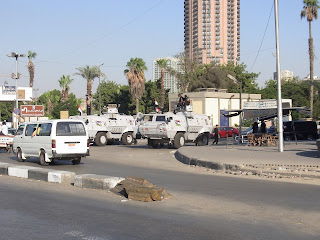Jesus, Mary and Joseph supposedly lived here and drank from the well around which Saints Sergius and Bacchus Church would be built. The jagged edges of Cairo are smoothed away in this pre-Islamic cluster of parishes. Dipping my toe into the history of this place reminds me of the sea of wonders that lie in Al-Sayyida Zeinab and Islamic Cairo to the northeast. The entire city is an outdoor museum, and 336 hours is time enough only to skim the surface.
Sometimes I feel I am the only tourist here. Nobody notices as I climb the bell ringer's stairs to the roof of the Hanging Church, built around 300 A.D. Muhammad would not be born for another 300 years. The view from the top:
The Copts are a distinct religious minority, making up about 1 out of every 10 Egyptians. They're Christian, obviously, but speak Arabic and have a complicated history I can't pretend to understand.
Some views from inside the Hanging Church.
These pictures, painted on wood, are iconic, in the original sense of the term. They're considered to be not just representations of saints and angels, but to be sacred in and of themselves. Almost an otherworldly concept. People from the neighborhood come in to touch them, one by one, then leave. The picture frames say 18 A.D., but that can't be right. They look newish, maybe 300 years old.
St. Nofer the Hermit:
A crowned Virgin Mary with her baby riding shotgun. She's stabbin' a snake.
These appear to be the oldest icons in the building, painted directly on the apse. I think they're from around 700 A.D. The arrangement and age remind me of the mosaics uncovered at the Haghia Sophia in
Istanbul, so I'm guessing Mary is involved, possibly the Archangel Gabriel and somebody else.
The Coptic Museum is just around the corner. The lighting, presentation and signage is superb. Truly one of the great museums I've ever visited. Lots of portrait fragments from the fifth century, incunabula from the 1100s, and tons of icons.
Some highlights: 1) Part of an 18th-century triptych featuring Saints Ahraqas and Augani. They have the bodies of men and the faces of dogs -- an attenuated link to Egypt's pharaonic past. 2) St. Victor on horseback, trampling a dragon. 1700s, by Yuhanna Armani. 3) The many tediously produced, vividly colored pre-Gutenberg books.
Sadly, no photos are allowed in the Coptic Museum, nor are they in the Egyptian Museum. And in general, Egyptians don't seem crazy about having their pictures taken, so it can be a challenging place for a photographer.
Outside the museum are the ruins of the Babylon Fortress (below), built around 500 A.D. The Nile used to flow nearby, but it's since changed its course several hundred yards away. Jesus' dad, er, stepdad ... whatever, is believed to have worked nearby.
A cool doorway in Coptic Cairo.
Saints Sergius and Bacchus Church, on the site where the holy family drank their fill.
In a mini-
Deesis, Jesus touches his thumb to his ring finger (the original gang sign?).
At St. Barbara Church, there is some chanting going on, but in what language? Sumerian! (Allow me a moment to Google it.) Sumerian is the oldest written language in the world and was spoken here 3,000 years ago, when the pyramids were still encased in a gleaming limestone veneer.
st.barbara.church from
Sluggh McGee on
Vimeo.
These guys are tearing down an old building at the El Gawhary Tomb. Yeah, I don't know what's going on either.
I sense a startling psychological aspect emanating from this spot. Behind the skillful devotional art is a rippling agony. Jesus' death created a thunderclap along the Nile that echoes to this day. Hungry to learn more, I return the following afternoon with Martin. My Arabic is so-so, but he's a native speaker and better actor, and I need him to open some doors that are closed to me. He delivers, surprising even himself. More on that later.
After a hot, crowded metro ride, I'm getting closer to home.
Getting groceries at home is a production, but everything is so damned convenient here. Whatever you need is just steps away.


















































